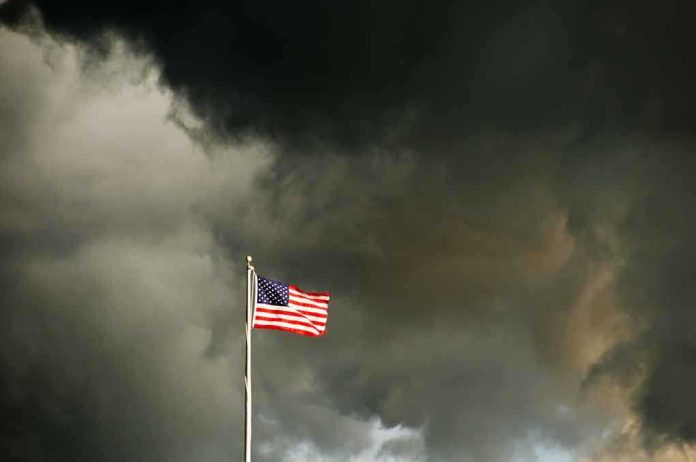
The sky over the American South has rarely looked so menacing—or so full of deadly potential—as more than 50 million people stand squarely in the path of a record-breaking tornado season that refuses to follow the rules of the calendar.
Story Highlights
- Over 50 million people across the South are under threat from tornadoes and destructive winds as a major fall storm system strikes.
- The 2025 tornado season is nearly double the historical average, with multiple unprecedented outbreaks and long-track tornadoes.
- Communities already battered earlier in the year now face renewed danger, compounding vulnerabilities and straining emergency response.
- Meteorologists and experts point to unusual atmospheric patterns and Gulf moisture as drivers of this relentless and historic storm activity.
Fall’s Fury: Tornadoes Strike the South When Least Expected
October in the South should mean golden leaves and football, not tornado sirens. Yet, on October 18 and 19, 2025, Arkansas, Louisiana, and Mississippi found themselves in the bullseye as a sprawling storm front unleashed radar-confirmed tornadoes and destructive winds. The sheer scale is hard to fathom: over 50 million Americans from Texas to the Carolinas faced urgent warnings, as emergency alerts lit up phones and broadcasters switched to wall-to-wall storm coverage.
For those with memories of spring’s devastation still fresh, the sense of déjà vu was chilling. Homes, schools, and businesses—many still sporting tarps from earlier outbreaks—were again in harm’s way. Power lines fell, roads disappeared under debris, and first responders scrambled as reports of injuries and destruction mounted. State and local officials, well-versed in tornado protocol after a relentless year, activated shelters and dispatched search and rescue teams into the teeth of the storm.
The Relentless 2025 Tornado Season: Records Shattered
By October, the 2025 tornado season had already passed into the realm of the extraordinary. With 473 tornadoes reported by early April—nearly double the 16-year average—the U.S. had witnessed a drumbeat of violent weather mostly in the Southeast and Mississippi Valley. March brought a stunning 115 confirmed tornadoes in just two days, including three EF4 monsters that left a trail of fatalities and ruined communities from Mississippi to Indiana. April and May offered little respite, with outbreaks stacking atop each other, and at least one tornado reported for twelve consecutive days—a feat meteorologists had never seen so early in the year.
October’s outbreak, however, was particularly alarming for its timing. Tornadoes are a springtime threat in most of America, but this fall event arrived outside the historic peak, catching many off guard. The atmospheric setup—a potent clash of strong pressure systems and Gulf of Mexico moisture—created ideal conditions for tornadoes that tore across the heart of Dixie as if the calendar had flipped back to April.
Communities Under Siege: Emergency Response and Human Impact
Residents of Arkansas, Louisiana, and Mississippi, already fatigued by months of severe storms, found themselves making hard choices: shelter in place, risk evacuation, or seek refuge at hastily opened community centers and schools. Local hospitals prepared for a potential surge in injuries, while businesses braced for another round of closures and costly repairs. For the elderly, disabled, and those without reliable transportation, the threat was magnified. Some towns, battered by previous tornadoes, now faced the economic and emotional weight of rebuilding yet again, with insurance claims and federal disaster aid slow to keep pace with the destruction.
State and local emergency agencies worked closely with federal partners, deploying mobile command centers and activating mutual aid agreements. For many, the ongoing crisis was a stark reminder that disaster resilience—much discussed in political circles—remains a work in progress on the ground.
The Science and the Stakes: Why This Outbreak Matters
Meteorologists and academic experts have pointed to a rare confluence of factors behind 2025’s tornado onslaught. Unusually warm Gulf waters, persistent pressure systems, and a shifting jet stream have combined to produce an atmosphere primed for severe weather. While some experts see fingerprints of climate variability and even climate change, others caution that natural weather cycles can also produce outlier years. The one point of consensus: the intensity and persistence of this season’s outbreaks are virtually without precedent.
For the insurance industry, utilities, and local governments, the implications are profound. Economic losses mount with every storm, infrastructure repairs lag behind need, and public trust in emergency preparedness is put to the test. Politicians, meteorologists, and ordinary citizens alike are now debating what must change as the South stares down the barrel of yet another severe weather threat—this time well past the supposed end of tornado season.
Sources:
AccuWeather: Tornado outbreaks and 2025 season analysis
Wikipedia: Tornadoes of 2025, event timelines, and statistics
Wikipedia: List of United States tornadoes from August to October 2025
Watchers News: October 18–19, 2025, outbreak details













